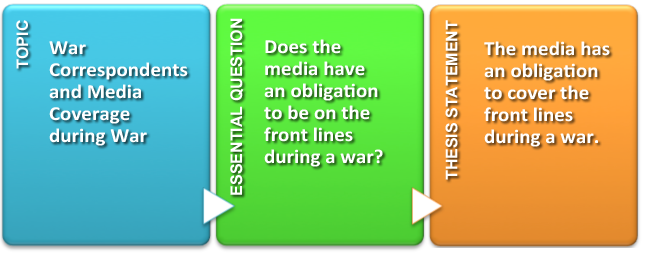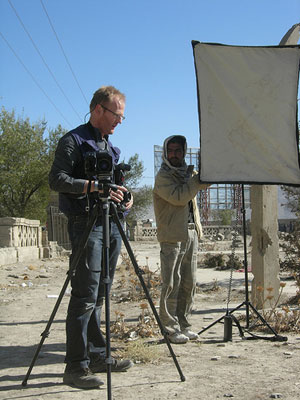
Source: Photo journalist Louis Quai, Carl Montgomery, Flickr
So far we have chosen a topic for a persuasive essay and formed the essential question to help us focus our topic. Now we are going to create a thesis statement. In the thesis statement, you must state a position about your topic and answer the essential question in a complete sentence. Here’s an example:
- Issue: War Correspondents and Media Coverage during War
- Essential question: “Does the media have an obligation to be on the front lines during a war?”
- Writer’s position: Yes, the media should cover the front lines during a war.
- Working thesis statement: The media has an obligation to cover the front lines during a war.
A good thesis statement declares what you believe and what you intend to prove. It is the difference between a thoughtful persuasive essay and a simple retelling of facts.
The characteristics of a good thesis statement are as follows:
- It should be contestable and propose an arguable point with which people can reasonably disagree.
- It should be provocative; it takes a stand and justifies the discussion you will present.
- It tackles a subject that can be adequately covered in the assigned format. In other words, is the topic specific enough? If you have a two-page limit, for example, choose a topic that can be covered in the allotted space and not a topic that needs eight pages to be properly developed. Instead of “music,” think “Seattle grunge in the 1990s.” A good thesis statement is specific and focused.
- It asserts your conclusion based on evidence. The evidence or support can include statistics, facts, excerpts from literature, quotes from experts, and more.
- It provides your readers with a map to guide them through your essay. The readers will know what your position is and will be able to follow the supporting points.
- It anticipates and refutes counterarguments.
As you develop a thesis statement, remember these tips:
- Avoid vague language (i.e., “it seems”).
- Avoid the first person (i.e., “I believe” or “In my opinion”).
- Ensure that it passes the “So What?” or “Who Cares?” test. Would your most honest friend ask why he should care, or would he respond,“but everyone knows that”? Consider this thesis statement: “People should avoid driving under the influence of alcohol.” This statement would be unlikely to evoke any opposition and also doesn’t tell the reader anything new. This statement is still more topic than thesis. If, however, you said, “People who drive drunk should have their license revoked after the first offense,” then you have developed a thesis that passes the “so what” test. This position will evoke different responses from readers.
To know if you have a solid working thesis, answer these questions.
- Does the thesis inspire a reasonable reader to ask “How?” or “Why?”
- Does the thesis avoid general phrasing and sweeping words such as “all” or “none” or “every”?
- Does the thesis lead the reader toward the topic sentences or the subtopics needed to prove the thesis?
- Can the thesis be adequately developed in the assigned length?
If you cannot answer “YES” to these questions, revise your thesis so that it passes these tests.
Is the statement
 contestable?
contestable? provocative? Something people disagree about?
provocative? Something people disagree about? specific enough for assignment?
specific enough for assignment? based on evidence or possible to support with evidence?
based on evidence or possible to support with evidence? clear in revealing the writer’s position?
clear in revealing the writer’s position?
Now apply what you have learned about a good thesis statement by evaluating the examples below. Decide whether each thesis statement in the exercise is satisfactory or not. To record your answer, click the “Yes” or “No” box. You can refer to the chart that follows to help you decide. Remember that a satisfactory thesis statement will contain all of the characteristics shown in the chart.
1. Teenagers and cosmetic surgery.
2. Social media, such as Facebook and Twitter, can have a positive impact on learning.
3. A career in graphic arts would be fun.
4. Internet radio is the best thing to happen to music in 20 years.
5. Teachers should limit the amount of homework they assign to 30 minutes per class.
6. High school students should have part-time jobs because working at a job teaches them the values of responsibility and time management.
Once again, a good thesis statement doesn’t just state a fact or opinion. It asserts something.
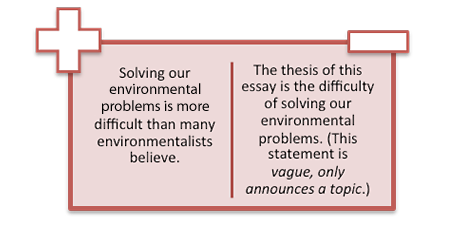
A good thesis statement is the main idea, not the title. It must be a complete sentence that explains in some detail what will be in the essay.

A good thesis statement is specific rather than vague or general.
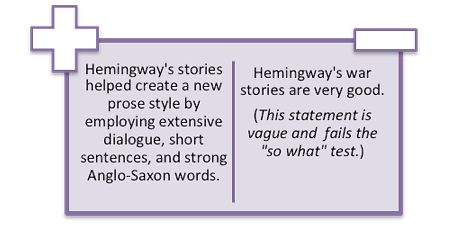
A good thesis statement has one main point, not several main points. More than one point may be too difficult for the reader to understand and the writer to support.
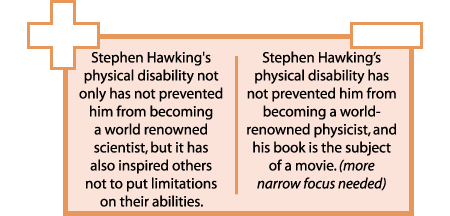
Remember, the purpose of persuasive writing is to convince an audience to consider your position. Effective persuasive writing presents an opinion and supports it with good, sound reasoning. This reasoning is based on facts, statistics, expert opinion, or textual evidence that lends authority to your position.
Let’s return to our topic about media coverage during war. Here’s what we have so far:
